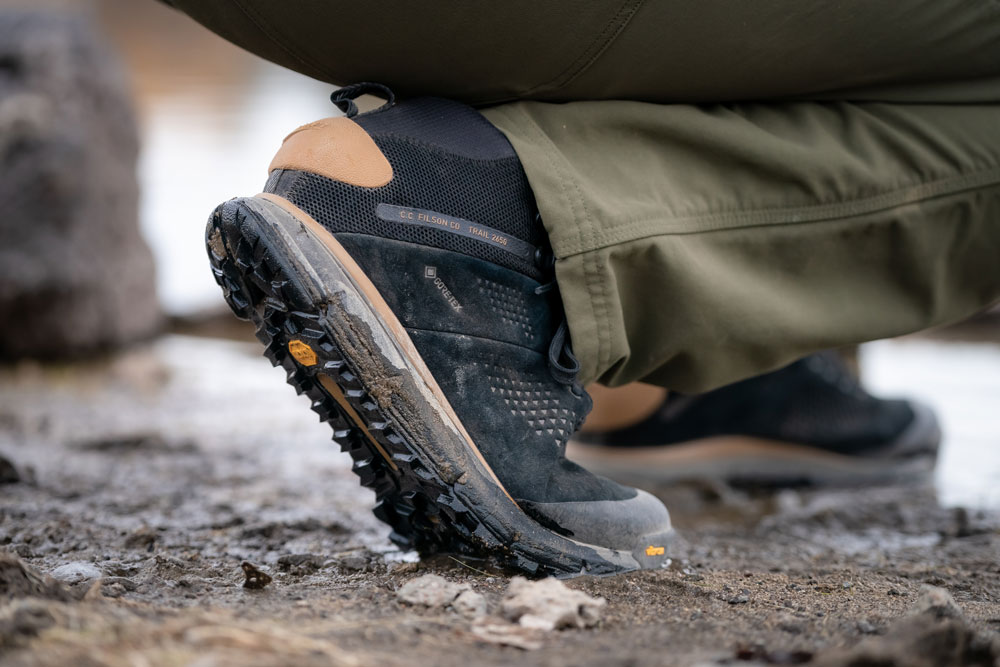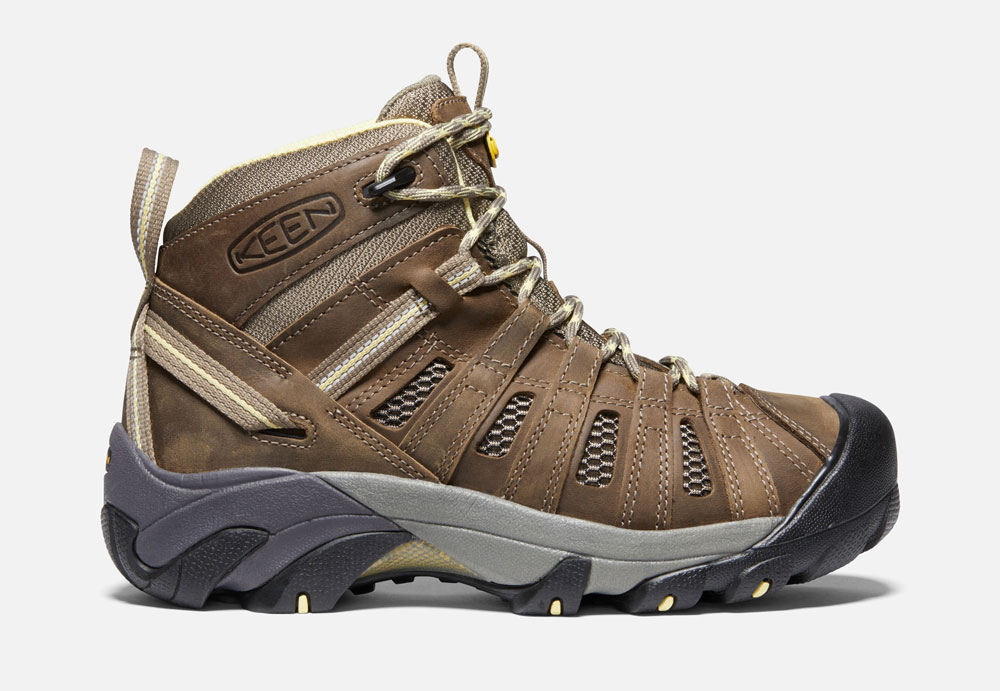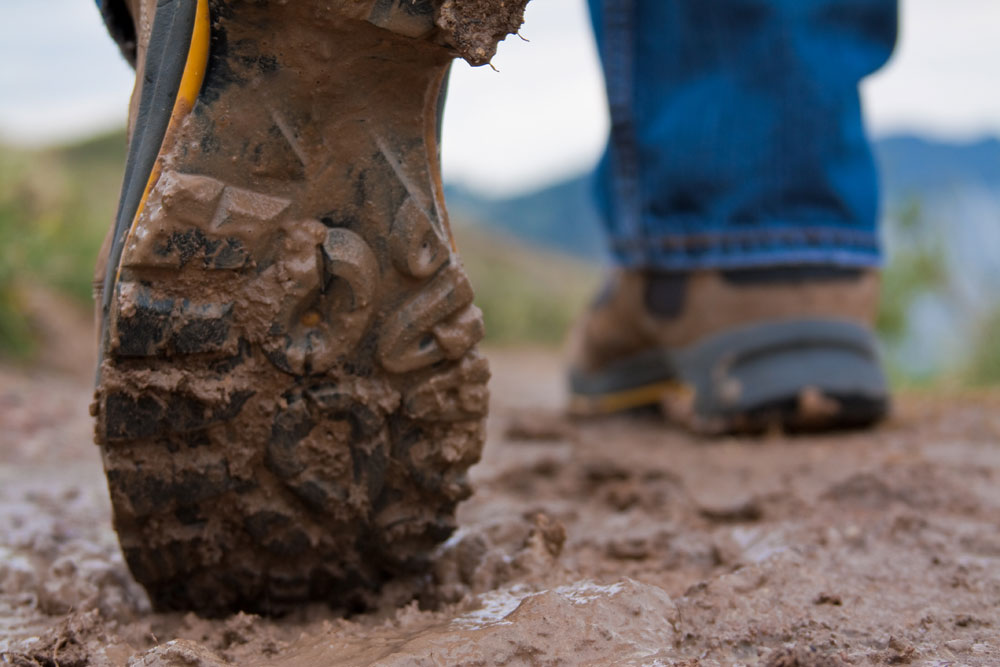As the snow melts and spring approaches, it’s time to start thinking about the best hiking boots for warm weather. You’ll want to ensure whatever hiking boot you select for warm weather trail exploration possesses the qualities for the terrain you’re walking in, such as ventilation, breathability, durability and waterproofing.

The Top 5 Best Breathable Hiking Boots
There are plenty of high-quality hiking boots on the market that perform well in warm weather. We’ve selected these five hiking boots based on their breathability, weight, support and durability.
1. Danner x Filson Trail 2650 Mid
The Danner x Filson Trail 2650 Mid was made with the modern hunter in mind, striking a careful balance between lightweight performance and a heritage-inspired design. Designed to blend seamlessly into your outdoor gear setup, the Danner x Filson Trail 2650 Mid features versatile black mesh with tan detailing that nods to Filson's legendary Tin Cloth. A co-branded tongue patch and outer detailing confirm the collaboration of two legendary Pacific Northwest brands.
When the day’s plan calls for moving far and fast, you want to be prepared for whatever weather you may encounter. Versatile gear is key, and footwear is no exception. That's why the Danner x Filson Trail 2650 Mid is made with breathable GORE-TEX that keeps water out while still allowing moisture to vent. An extra inch of height around the ankle provides protection and added stability. With comfortable feet, you can focus on the day's exploration without distraction.

2. Oboz Footwear Women’s Arete Mid
The Women’s Arete Mid is ideal for active trail hikers who want a lightweight boot with a form-hugging heel and sculpted midfoot. You can count on plenty of support from this hiking boot on uneven terrain without feeling weighed down or suffocated by their build, thanks to the high-density EVA sculpted arch and TPU toe caps to prevent injury from rocks and roots on the trail.
You’ll enjoy the comfort of the O FIT Insole™, which is custom-designed to fit the hiking boot and deliver the ideal support for women.
The upper layer features moisture-wicking fabric composed of breathable mesh and absorbent material that draws heat and moisture away from your feet, ensuring you stay cool and dry.
This is a performance hiking boot that is lightweight and breathable, featuring the Vibram® XS Trek outsole. The Topo Athletic Trailventure boot delivers quality traction so you can tackle tough terrain while providing cushion on the bottom of your foot for a comfortable day of trekking. It also features a hard rubber toe cap to increase protection for your feet when hiking on uneven terrain.
The mesh upper facilitates fast evaporation for outstanding perspiration management, keeping your feet dry even after hours on the trail. There are also two lacing tension options to provide you with customized support.
4. Irish Setter Vaprtrek 8-inch Waterproof Boot
Updated with a fresh yet familiar look, the all-new VaprTrek family is packed with performance-enhancing improvements. Perfect for hunting, hiking, or weekends in the field, these boots are even lighter than before and feature new technologies that enable better traction on rough terrain, greater overall durability, and outstanding all-day comfort.
With ScentBan and RPM technology, these boots fight odors and are lightweight and comfortable while being durable and strong.
5. Keen Footwear Women’s Voyageur Mid

The Voyageur Mid is a rugged and stylish hiking boot with mesh inserts for ventilation. They have a mesh lining and upper and are made of water-resistant leather. You can also say goodbye to smelly feet, thanks to Cleansport NXT™ built-in natural odor control.
In addition to being extremely breathable, the Voyageur Mid uses Metatomical Footbed Design to cradle the foot, hugging all contours for exceptional support on the trail. The dual-density EVA footbed is removable.
Features to Look For in Warm Weather Hiking Boots
The last thing you need is your hiking boots weighing you down on a warm summer trek when they should be putting extra spring in your step. Unless you know you’ll be encountering wet terrain that could seep into your footwear, it’s best to forgo waterproof options for warm weather hiking unless the breathability of the boot is not compromised.
If your boots aren’t breathable enough, it can cause your feet to sweat a lot, which can result in blisters and discomfort. Mid- to low-cut boots are an excellent choice for letting your ankles breathe better, as long as you’re not entering any extremely rocky terrain. If that is the case, additional support for your ankles would be safer, especially if you’re hiking by yourself.

How to Choose the Best Boots
The best hiking boots for your next trip on the trails need to be supportive and rugged and prevent your feet from sweating during the summer. Whether you’re an avid hiker or simply training for hiking, you’ll feel more comfortable and confident when choosing the right boots.
To choose the proper hiking boots, you’ll need to spend some time in them. Don’t rush through the process of trying them on at the store but really let yourself explore how it feels to move in them. Bring along the socks you intend to wear when hiking to see how the boots feel when wearing them. If you’re going to shop online for hiking boots, consider sticking to a familiar brand so you can be confident the size you purchase will be comfortable.
Remember, hiking boots should fit snugly with no wiggle room. The boot must be tight enough to support you but not so tight it puts uncomfortable pressure on any part of your foot. It’s best to shop for hiking boots later in the day to get a more accurate size measurement of your feet after you’ve been walking on them for hours, as they tend to swell.
If you’re going to be traveling to a new region or even a different country for multi-day treks, a hiking boot that prepares you for multiple situations is ideal. It’s possible to find waterproof hiking boots that still offer mesh lining, mesh uppers or removable membranes, promoting ventilation and breathability.
Low hiking boots are more lightweight, ideal for warm weather and shorter hikes that only take a day. If you’re going on longer treks with more unpredictable terrain, you will benefit from the additional support a mid boot provides.

Breaking in Your Boots
After you’ve found the perfect pair, it is critical to break in your new boots to prevent blisters and injuries on the trail.
Start by wearing your boots around the house with the socks and insoles you plan to use on your hike. When lacing up, make sure the tongue and the gusset are aligned and the boots are tied snuggly. Wear them for 15-30 minutes at a time throughout the day.
Once you’re comfortable wearing them for short periods with minimal activity, try going for a walk around the block or to your local park. Choose a route with a few hills to make sure the boots feel good at various inclines.
Finally, take your boots on a short trek wearing a backpack. Go on several short hikes over the coming weeks, gradually increasing the amount of weight in your pack.
Lace Up and Get Started
The perfect boot for your next warm weather hike should be durable, lightweight and breathable to keep your feet dry while you soak in the sun and fresh air.
Remember to select your boots with the location of your trek in mind, and be fastidious during the process of trying on boots in order to find the perfect fit.



























